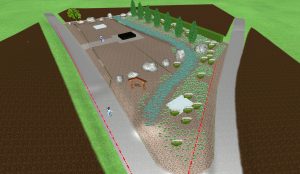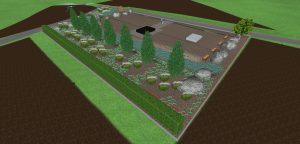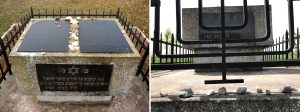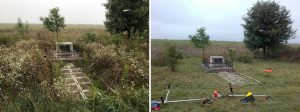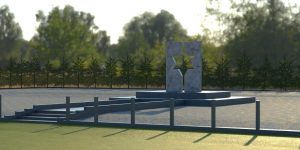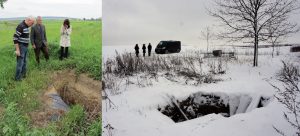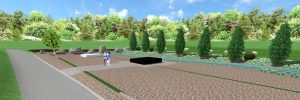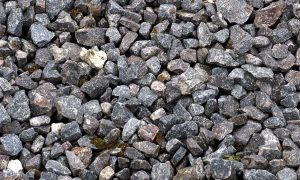![]() Ця сторінка також доступна українською.
Ця сторінка також доступна українською.
Introduction
This page summarizes and analyzes a project which developed project concepts and detailed designs to enhance protection and commemoration of a site of mass killing and burial of Jews during the German occupation near the southern border of the town of Rohatyn (Ivano-Frankivsk oblast) during World War II, one of two such sites in the town. The project extends an earlier commemoration effort by survivors and descendants of Rohatyn Jewish families plus the Rohatyn City administration in the late 1990s, as well as a small Soviet monument erected in the 1980s, with new research and documentation, landscape architecture and design work, as well as detailed planning and costing of the project. Two alternate designs were considered, however the projected costs have to date inhibited physical implementation of either design. Project planning and design reports are published on the project leaders’ website, together with summary information about project motivations, design features, and costs. This project coordinates directly and indirectly with several other projects managed by the same organization.
This page is intended as a reference for similar projects now in the planning stages in western Ukraine or beyond. Following a brief summary of the site, the material below describes the project and reviews its effectiveness together with a listing of issues encountered, approximate project costs, and ongoing risks. Related projects both in western Ukraine and elsewhere in Europe are also briefly mentioned, for comparison. At the bottom of this page are links to project documentation and to additional reference information about the burial site and related projects.
Read the overview to case studies of selected projects at Jewish burial sites in western Ukraine.
Project Summary
Project type: Research, design, and development of enhanced protection, signage, and memorial features at a known Jewish mass grave site.
Location and site type: “South” Jewish mass grave of Rohatyn, Rohatyn raion, Ivano-Frankivsk oblast, Ukraine. GPS: 49.40350, 24.62760.
Description of the site: Based on non-invasive GPR survey data and analysis, the physical mass grave pit perimeter is an unmarked irregular shape bounded by a rectangle approximately 30m wide by 40m long, enclosing roughly 0.12 hectare of area, on a slight rise with gentle slope. The site is about 1.5km southeast from the town square and former ghetto (about 2km by roads) in a remote area without visibility to the town center. The grave perimeter is flanked on two sides by unpaved rural roads, and on two other sides by farm fields in active cultivation.
Ownership and stakeholders: The mass burial site is owned by the municipality of Rohatyn. Stakeholders include Rohatyn Jewish Heritage (a Ukrainian heritage preservation NGO), the local civil community, foreign descendants of Rohatyn pre-war Jewish and other families, historians, and students of Jewish culture.
Official heritage status: The Soviet memorial monument is recorded on the Ivano-Frankivsk oblast list of recorded heritage objects; neither the Jewish memorial monument nor the site itself is recorded on the same list. In 2020, the City of Rohatyn applied for and was granted ownership of and responsibility for the site by the oblast administration.
Activists working on/at the site: Rohatyn Jewish Heritage (RJH), a registered non-profit organization based in Lviv, Ukraine. Contact info.
Other projects active at the site: Digital documentation of the history of the mass grave and the Jewish community (see RJH heritage page); maintenance, seasonal clearing of wild vegetation, and annual planting of flowers (see RJH project page); past memorial monuments and dedication ceremony; and annual commemoration of the killing event at the site (see RJH news reports from the 75th anniversary and subsequent years).
Project Analysis
History of the site: According to Jewish and other memoirs, a brick-making operation had been at or near the site between the world wars, and some months prior to the massacre Jews had been forced by the German occupiers to dig pits there under the guise of anti-tank defenses. On the morning of March 20, 1942, more than 3000 Jews (mostly Rohatyn residents with some refugees and forcibly displaced people from nearby towns) were rounded up at gunpoint in the ghetto, forcibly marched or transported through the town square to the site, and shot to death in a single day. For a few days after, Jewish men and boys who had survived in hiding were forced to collect frozen corpses in the town, then move them to the site and into the pits. Before the bodies were completely covered with soil, a few witnesses from Rohatyn and nearby villages saw the results of the killing. After the German army was expelled from the District of Galicia in 1944 and Soviet authorities occupied the region, the site was officially ignored, though local farmers avoided it and the ground surface was visibly different for a time. Eventually all traces of the physical grave area disappeared, though farmers continued to avoid planting crops there.
Shortly before the collapse of the Soviet Union, sometime in the 1980s a monument was erected on a corner of the site (not at the physical grave) by the authorities, commemorating “Victims of Fascism” without mention of their Jewish identity. Following Ukraine’s independence, Jewish survivors of the Holocaust in Rohatyn together with descendants of Rohatyn Jewish families who had emigrated before WWII raised funds to erect a second monument more central at the site, and with more descriptive text and Jewish symbolism. A dedication ceremony was held at the site in summer 1998 with these survivors and descendants as well as the City administration of Rohatyn, local religious leaders, historians, and others.
Current features of/at the site: Today the mass grave site retains its two memorial monuments as well as three very small concrete markers which may have once indicated speculative boundaries of the physical grave. One small and two large trees have grown on the site in recent years, situated somewhat randomly relative to other features. Rose bushes were planted to the sides of the Jewish memorial by local people during the 2010s. Otherwise wild vegetation (grasses, light shrubs, and poisonous hogweed) grows rapidly each year and must be trimmed; in some years, local farmers burn off the wild vegetation, as is customary in agricultural regions of western Ukraine. From time to time the site is vandalized by illicit digging for precious metals and military memorabilia. Illegal manholes have been opened several times since 2011, bringing human remains and clothing to the surface; police reports have sometimes been filed by RJH and local citizens after discovery of the holes.These holes were subsequently filled by the City of Rohatyn, but there is currently no protection against recurrence.
Details of the project: The project is proceeding in several stages: scientific research to define the boundary of the physical grave; registration and recognition of the site by civil authorities; landscape designs to enhance protection of the grave and the commemorative function of the site; implementation of a chosen design; long-term sustaining of the site and its features. A professional non-invasive ground-penetrating radar (GPR) survey of the site was made in 2017, as summarized on the RJH research report page; this effort resulted in definition of the irregular grave boundary within an uncertainty band of a few meters width.
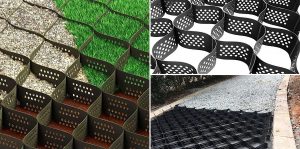
A typical geotextile grid stabilization system. Images © Standartpark.
Working with the GPR survey results, in 2019 RJH contracted the Lviv-based landscape architecture firm Green Garden to develop a costed new design for the site from RJH-defined project objectives. The project activists specified certain features to be included in the design: retention of the 1990s memorial monument (relocation permitted), the use of crushed rock to cover and protect the grave (with a nod to the Jewish tradition of leaving small stones at grave sites as memorial markers), and new signage with space for a history of the site and the Jewish community buried there. Landscape concepts provided by Green Garden included planting seven flame-shaped mature trees as a symbolic menorah and a stylized dry creek of rock and vegetation suggesting the Hnyla Lypa river which runs through Rohatyn. The firm conducted a topographic survey at and around the grave area; evaluated soils, roads, water, and local vegetation; created concept designs for crushed rock stabilization, grave protection, and aesthetic appearance; reviewed refined concepts and plans with RJH and the regional rabbinical authority; detailed the plans with drawings and simulations; and prepared a full cost analysis for materials, labor, management, and contingencies. As expected, and due to the complexity of the soil and ground slope adjacent to the road, the total cost to implement the project exceeded the funding amount which could feasibly be raised to continue with this design.
A second, alternate design was solicited in 2020 from Hryhoriy Arshynov, a regional engineer and builder with experience protecting Jewish mass grave sites in western Ukraine both as an independent contractor and as a member of the field working team of ESJF European Jewish Cemeteries Initiative. The alternate design incorporated an enhanced version of the ground stabilization treatment with concrete piles at the site perimeter and a deep geotextile grid, as well as a similar crushed rock grave cover, but simplified some of the decorative elements. Cost estimates for this version of the project also exceeded the capabilities of the project activists to raise funds, so the project team was discussing phased implementation and payment strategies when, regrettably, Mr. Arshynov lost his life to COVID-19.
At this time a third approach is in an initial research and coordination phase, through the “Connecting Memory” program, an effort funded by the German Federal Foreign Office and managed jointly by Germany’s Foundation Memorial to the Murdered Jews of Europe (in Berlin) and the Ukrainian Center for Holocaust Studies. This case study will be updated if/when substantial progress has been made.
Issues encountered in the project: In addition to the need for annual and seasonal care of the site to control wild vegetation and maintain the monuments, there are two significant issues which affect the site. The first is occasional (but almost annual) illicit digging into and around the mass grave by unknown persons who loot the grave for metals and other objects of value. Simply refilling the excavation holes and reburying unearthed human remains has not deterred repeated digging, and concepts to inhibit future digging and looting are either expensive (a full concrete cap) or impractical (electrical lighting and cameras). The other issue is the character of the soil over the grave and the slope of the ground around the grave. This necessitates grading and the installation of landscape stabilization features, which due to halakhic prohibitions against disturbing the ground, requires the addition of more soil onto the site.
Project costs, one-time and sustaining: The non-invasive GPR survey to locate and define the perimeter of the physical grave was part of a project surveying the two known Jewish mass graves in Rohatyn plus an investigation of possible mass graves in the new Jewish cemetery in Rohatyn, in 2017. The total cost of the surveys was US$24,900 plus an additional US$640 (and considerable volunteer work) for clearing vegetation ahead of the survey, and more than US$3000 in other costs for transportation and housing volunteers and contractors during the survey. The portion assigned to the south mass grave which is the subject of this case study is roughly estimated at US$11,000; the City of Rohatyn cleared vegetation at the south mass grave before the survey without charge to the project. Topographic survey, landscape architecture, and overall project planning and cost analysis for the Green Garden design was US$3080. The estimated project implementation cost for the Green Garden design was US$91,100 inclusive of management fees and taxes. The estimated project implementation cost for the Hryhoriy Arshynov design was US$46,100 inclusive of management fees and taxes.
Current risks to preservation: The primary risks to the site remain the issues noted above: ongoing wild vegetation growth, and illicit digging and looting. Until a project at the site can address these two issues successfully, the site will require vigilant monitoring and seasonal maintenance.
Related projects in western Ukraine: Memorial monuments have been erected at a number of Jewish cemeteries and mass graves in western Ukraine (see the monuments guide page for a variety of examples), but landscaping is quite rare at both types of burial sites. Recent examples include an ESJF-managed monument, fencing, and landscaping project at Katerynivka (Ternopil oblast), which used weed-suppressing landscape fabric and crushed rock as a ground cover and protection layer over the physical grave. In Pidhaitsi (also in Ternopil oblast), the cemetery and mass grave are covered with low-height dense grass which grows slowly and inhibits faster-growing grasses and shrubs, and the mass grave is outlined with a low concrete curb to visually define the space; together these features provide visual focus for visitors to the site and coordinate with a memorial monument near to the mass grave.
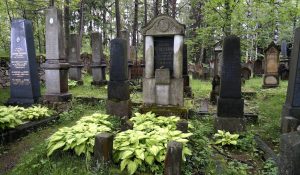
Plantings and tended wild growth in the Jewish cemetery of Dřevíkov in the Pardubice region of the Czech Republic. Photo © RJH.
Related projects outside western Ukraine: ESJF has also landscaped Jewish mass grave sites elsewhere in Ukraine outside the western oblasts, for example at Pyriatyn in Poltava oblast. There, landscaping added soil to prepare level ground, installed a perimeter concrete curb, poured a concrete cap over the center of the grave, and filled the space between cap and curb with crushed rock; a black granite memorial monument with inscriptions was installed on the concrete cap. Although new landscape design and construction at Jewish cemeteries is not common in the Czech Republic, energetic and long-term grounds maintenance by the small Jewish communities there, sometimes supported or led by municipalities and NGOs, has led to a large number of stable and tidy cemetery landscapes (often featuring mature trees shading the ground surface) with now well-preserved headstones, as described in a 2020 Jewish heritage blog post by Dr. Samuel D. Gruber. and visible in many photographs of historical Czech Jewish cemeteries on Wikimedia Commons.
References
- Rohatyn’s Shoah Killing Sites and Mass Graves – history and heritage description of the two wartime Jewish mass killing and burial sites in Rohatyn with maps and images by Rohatyn Jewish Heritage (RJH)
- Mass Grave Memorials Project – description and status of past, present, and future projects to protect and commemorate the two wartime Jewish mass killing and burial sites in Rohatyn including research, conservation, and proposed designs, by Rohatyn Jewish Heritage (RJH)
- Rohatyn South Mass Grave Landscape Design 2019 – an illustrated description with design drawings of a proposed project to enhance protection and commemoration of the south mass grave site in Rohatyn, presented by landscape architecture firm Green Garden under contract by Rohatyn Jewish Heritage (RJH)
- Rohatyn Mass Grave Survey 2017 – summary report of research methods and results to survey the boundaries of the two wartime Jewish mass burial sites in Rohatyn using non-invasive ground-penetrating radar (GPR) by the Centre of Archaeology at Staffordshire University and Rohatyn Jewish Heritage (RJH)
- The Shoah in Rohatyn – a chronology of the Jewish community of Rohatyn during the German occupation in World War II, including the events which led to the destruction of the community on March 20, 1942, researched and assembled by Rohatyn Jewish Heritage (RJH)
- Memoirs of Jewish Life in Rohatyn – a collection of summaries and links to personal memoirs as well as Yizkor Book compilations and other documentation of prewar and wartime Jewish life and death in Rohatyn, assembled by Rohatyn Jewish Heritage (RJH)
- Jack Glotzer’s Memoir “I Survived the German Holocaust Against All Odds” – a personal memoir by Jewish Holocaust survivor Jack Glotzer of Rohatyn, including his forced-labor experience burying murdered Jews at the Rohatyn south mass grave site, edited and published by the Glotzer family and Rohatyn Jewish Heritage (RJH)
- Yahad – In Unum Interviews with Rohatyn Holocaust Witnesses – a series of interviews with Ukrainian witnesses to the abuse and killing of Jews in the Rohatyn wartime ghetto, in town, and at the mass grave sites, conducted and recorded by Yahad – In Unum and transcribed/translated by Rohatyn Jewish Heritage (RJH)
- USHMM Encyclopedia: Ghettos of Rohatyn and the Region – a brief but formal history of events in the Jewish ghetto of Rohatyn and elsewhere in the town during the German occupation of eastern Poland (today’s western Ukraine), by the United States Holocaust Memorial Museum and Indiana University Press; Rohatyn is covered in Volume II, Part A, Section III: General Government, Eastern Galicia Region, pp.821-822
- The Kasejovice (Czech Republic) Jewish Cemetery: Typical and Beautiful – a blog post by Samuel D. Gruber on progress in Jewish cemetery preservation in the Czech Republic since the fall of Communism in Czechoslovakia, in Samuel Gruber’s Jewish Art & Monuments
- Survey of Historic Jewish Monuments in the Czech Republic – a 1994 survey report authored by Samuel Gruber and Phyllis Myers of the World Monuments Fund for the United States Commission for the Preservation of America’s Heritage Abroad

